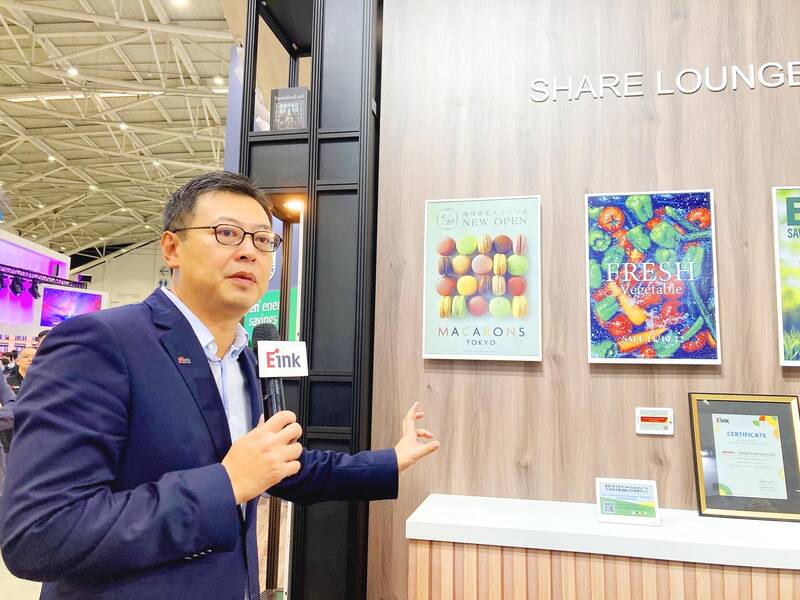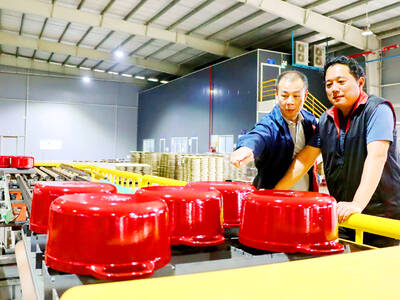E Ink Holdings Inc (元太科技), the world’s largest e-paper display supplier, yesterday said business is recovering gradually from an inventory correction cycle thanks to rapid and smooth technology upgrades in using new color e-paper displays on electronic readers and electronic shelf labels (ESLs).
The company said most customers are expected to level off extra older-generation color e-paper displays used in ESLs this quarter, resulting in a pickup in the third quarter. What is more encouraging is that a large retailer in North America has started replacing paper labels with ESLs, joining its European and Chinese peers.
The company expects new four color e-paper displays used in ESLs would account for about 90 percent, from 80 percent, of total ESL shipments.

Photo: Lisa Wang, Taipei Times
“We believe the first quarter is the lowest point. Our revenue in the second quarter will be better than the first quarter,” E Ink chairman Johnson Lee (李政昊) told media on the sideline of the Touch Taiwan display show in Taipei yesterday.
The main growth drivers this year would be electronic readers and electronic notebooks due to the display upgrade, Lee said.
“Customers said sales of their electronic readers with color displays are much better than they had expected,” Lee said, adding that the company’s equipment is fully utilized.
The company believes large e-paper displays would be the next growth driver, Lee said. The 32-inch cooler e-paper displays demonstrated equally good color performance compared with paper prints and should be a good replacement for paper posters, he said.
E Ink said that its new larger e-paper displays for public displays are to enter volume production early next year, after a new factory in Hsinchu starts operations at the end of this year.
Flat-panel makers AUO Corp (友達) and Innolux Corp (群創) also expect a gradual recovery starting in the second half of this year, backed by rising demand for panels used in large TVs and new artificial intelligence (AI) PCs.
AUO said demand for TV panels is picking up, indicating that the display industry has hit its bottom, after suffering the most in 2022 and last year.
The company witnessed a pickup in demand for 65-inch TV panels ahead of the Paris Olympics and UEFA Euro 2024, which are to take place in second and third quarters, AUO said.
“The display industry has weathered through the worst period in 2022 and 2023. The industry has returned to the healthy track,” AUO chairman Paul Peng (彭双浪) said. “We expect the introduction of AI PCs in the second half of this year to bring strong demand.”
The price of 65-inch TV panels are expected to rise at the fastest rate of 2.9 percent sequentially to about US$176 per unit this month, compared with price increases between 1.6 and 2.8 percent estimated for for 55-inch, 43-inch and 22-inch TV panels, price information provided by market researcher TrendForce Corp (集邦科技) showed.

STEEP DECLINE: Yesterday’s drop was the third-steepest in its history, the steepest being Monday’s drop in the wake of the tariff announcement on Wednesday last week Taiwanese stocks continued their heavy sell-off yesterday, as concerns over US tariffs and unwinding of leveraged bets weighed on the market. The benchmark TAIEX plunged 1,068.19 points, or 5.79 percent, to 17,391.76, notching the biggest drop among Asian peers as it hit a 15-month low. The decline came even after the government on late Tuesday authorized the NT$500 billion (US$15.2 billion) National Stabilization Fund (國安基金) to step in to buoy the market amid investors’ worries over tariffs imposed by US President Donald Trump. Yesterday’s decline was the third-steepest in its history, trailing only the declines of 2,065.87 points on Monday and

TAKING STOCK: A Taiwanese cookware firm in Vietnam urged customers to assess inventory or place orders early so shipments can reach the US while tariffs are paused Taiwanese businesses in Vietnam are exploring alternatives after the White House imposed a 46 percent import duty on Vietnamese goods, following US President Donald Trump’s announcement of “reciprocal” tariffs on the US’ trading partners. Lo Shih-liang (羅世良), chairman of Brico Industry Co (裕茂工業), a Taiwanese company that manufactures cast iron cookware and stove components in Vietnam, said that more than 40 percent of his business was tied to the US market, describing the constant US policy shifts as an emotional roller coaster. “I work during the day and stay up all night watching the news. I’ve been following US news until 3am

Six years ago, LVMH’s billionaire CEO Bernard Arnault and US President Donald Trump cut the blue ribbon on a factory in rural Texas that would make designer handbags for Louis Vuitton, one of the world’s best-known luxury brands. However, since the high-profile opening, the factory has faced a host of problems limiting production, 11 former Louis Vuitton employees said. The site has consistently ranked among the worst-performing for Louis Vuitton globally, “significantly” underperforming other facilities, said three former Louis Vuitton workers and a senior industry source, who cited internal rankings shared with staff. The plant’s problems — which have not

TARIFF CONCERNS: The chipmaker cited global uncertainty from US tariffs and a weakening economic outlook, but said its Singapore expansion remains on track Vanguard International Semiconductor Corp (世界先進), a foundry service provider specializing in producing power management and display driver chips, yesterday withdrew its full-year revenue projection of moderate growth for this year, as escalating US tariff tensions raised uncertainty and concern about a potential economic recession. The Hsinchu-based chipmaker in February said revenues this year would grow mildly from last year based on improving supply chain inventory levels and market demand. At the time, it also anticipated gradual quarter revenue growth. However, the US’ sweeping tariff policy has upended the industry’s supply chains and weakened economic prospects for the world economy, it said. “Now